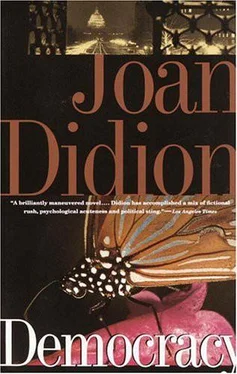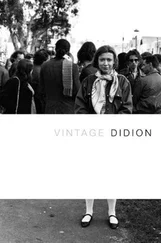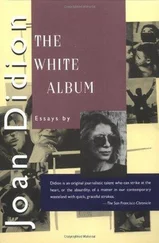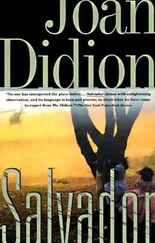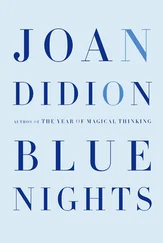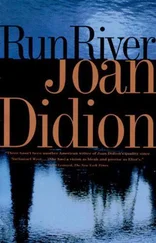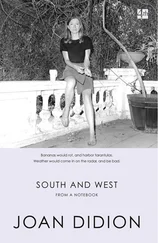She left dark red lipstick marks on her cigarettes, smoked barely at all and then crushed out in coffee cups and Coke bottles and in the sand. She sat for hours at her dressing table, which was covered with the little paper parasols that came in drinks, yellow, turquoise, shocking pink, tissue parasols like a swarm of brittle butterflies. She sat at this dressing table and shaved her legs. She sat at this dressing table and smoothed Vaseline into her eyebrows. She sat at this dressing table and instructed her daughters in what she construed to be the language of love, a course she had notably failed. For a year or two after Carol Christian left Honolulu Janet would sit on the beach at Lanikai and sift the sand looking for cigarettes stained with her mother’s lipstick. She kept the few she found in a shoebox, along with the tissue parasols from Carol Christian’s dressing table and the postcards from San Francisco and Carmel and Lake Tahoe.
Of the daughters I was at first more interested in Janet, who was the younger, than in Inez. I was interested in the mark the mother had left on Janet, in Janet’s defensive veneer of provincial gentility, her startling and avid preoccupation with other people’s sexual arrangements; in her mercantile approach to emotional transactions, and her condescension to anyone less marketable than she perceived herself to be. As an adolescent Janet had always condescended, for example, to Inez, and became bewildered and rather sulky when it worked out, in her view, so well for Inez and so disappointingly for herself. I was interested in how Janet’s husband Dick Ziegler made a modest fortune in Hong Kong housing and lost it in the development of windward Oahu. I was interested in Inez and Janet’s grandmother, the late Sybil “Cissy” Christian, a woman remembered in Honolulu for the vehement whims and irritations that passed in that part of the world as opinions, as well as for the dispatch with which she had divested herself of her daughter-in-law. Aloha oe . “I believe your mother wants to go to night clubs,” Cissy Christian said to Inez and Janet by way of explaining Carol Christian’s departure. “But she’s coming back,” Janet said. “Now and then,” Cissy Christian said. This conversation took place at lunch at the Pacific Club, one hour after Inez and Janet and their uncle Dwight saw the reconditioned Lurline sail. Janet bolted from the table. “Happy now?” Dwight Christian asked his mother. “Somebody had to do it,” Cissy Christian said. “Not necessarily before lunch,” Dwight Christian said.
I saw it as a family in which the colonial impulse had marked every member. I was interested in Inez and Janet’s father, Paul Christian, and in the way in which he had reinvented himself as a romantic outcast, a remittance man of the Pacific. “He’s going to end up a goddamn cargo cult,” Paul Christian’s brother Dwight once said about him. I was interested not only in Paul but in Dwight Christian, in his construction contracts at Long Binh and Cam Ranh Bay, his claim to have played every Robert Trent Jones golf course in the world with the exception of the Royal in Rabat; the particular way in which he used Wendell Omura to squeeze Dick Ziegler out of windward Oahu and coincidentally out of the container business. “Let me give you a little piece of advice,” Dwight Christian said when Paul Christian took up Dick Ziegler’s side in this matter. “ ‘Life can only be understood backwards, but it must be lived forwards.’ Kierkegaard.” Dwight Christian had an actual file of such quotations, most of them torn from the “Thoughts on the Business of Life” page in Forbes and given to a secretary to be typed out on three-by-five index cards. The cards were his hedge against a profound shyness. “Recently I ran across a thought from Racine,” he would say on those occasions when he was called upon to chair a stockholders’ meeting or to keynote the Kick-off Dinner for Punahou School Annual Giving or to have his picture taken, wearing a silk suit tailored in Hong Kong and an aluminum hard hat stencilled “D.C.,” knee-deep in silica sand in the hold of a dry-bulk carrier.
That particular photograph appeared in Business Week , at the time Dwight Christian was trying (unsuccessfully, it turned out) to take over British Leyland.
I also had two photographs from Fortune , one showing Dwight Christian riding a crane over a cane field and the other showing him astride an eighteen-thousand-ton concrete dolos, with a Pan American Cargo Clipper overhead.
In fact I had a number of photographs of the Christians: in that prosperous and self-absorbed colony the Christians were sufficiently good-looking and sufficiently confident and, at least at the time Inez was growing up, sufficiently innocent not to mind getting their pictures in the paper. I had Cissy Christian smoking a cigarette in a white jade holder as she presented the Christian Prize in Sugar Chemistry at the University of Hawaii in 1938. I had Dwight and Ruthie Christian tea-dancing at the Alexander Young Hotel in 1940. I had Carol Christian second-from-the-left in a group of young Honolulu matrons who met every Tuesday in 1942 to drink daiquiris and eat chicken salad and roll bandages for the Red Cross. In this photograph Carol Christian is wearing a Red Cross uniform, but in fact she was invited to join this group only twice, both times by Ruthie Christian. “Spend time around that crowd and you see how the green comes out,” she said when it became clear that she would not be included on a regular basis. “You see how the green comes out” was something Carol Christian said often. She said it whenever she divined a note of rejection or criticism or even suspended judgment in someone’s response to her, or, by extension, to Inez or Janet. She seemed to believe herself the object of considerable “envy,” a word Inez tried to avoid in later life, and perhaps she was.
“I detect just the slightest tinge of lime.”
“Positively chartreuse.”
“You find out fast enough who your friends are.”
In fact it would have been hard to say who Carol Christian’s friends were, since she had no friends at all who were not primarily Paul Christian’s friends or Cissy Christian’s friends or Dwight and Ruthie Christian’s friends. “Seems like a nice enough gal,” one of Paul Christian’s cousins said about her when she had lived in Honolulu for ten years. “Of course I haven’t known her that long.”
I had, curiously, only two photographs of Paul Christian, and neither suggested the apparent confidence and innocence with which his mother and his brother and even his wife met the camera. The first showed Paul Christian playing backgammon with John Huston in Cuernavaca in 1948. Paul Christian was barefoot and dark from the sun in this snapshot, which would have been taken at roughly the time arrangements were being made for his wife to leave Honolulu on the reconditioned Lurline . The second photograph was taken as Paul Christian left the Honolulu YMCA in handcuffs on March 25, 1975, some hours after he fired the shots that resulted in the immediate death of Wendell Omura and the eventual death of Janet Christian Ziegler. In this photograph Paul Christian was again barefoot, and had his cuffed hands raised above his head in a posture of theatrical submission, even crucifixion; a posture so arresting, so peculiarly suggestive, that the photograph was carried in newspapers in parts of the world where there could have been no interest in the Christians or in Wendell Omura or even in Harry Victor. In most parts of the United States there was of course an interest in Harry Victor. VICTOR FAMILY TOUCHED BY ISLAND TRAGEDY, the caption read in the New York Times .
You see the shards of the novel I am no longer writing, the island, the family, the situation. I lost patience with it. I lost nerve. Still: there is a certain hour between afternoon and evening when the sun strikes horizontally between the trees and that island and that situation are all I see. Some days at this time one aspect of the situation will seem to me to yield the point, other days another. I see Inez Christian Victor in the spring of 1975 walking on the narrow beach behind Janet’s house, the last sun ahead of her, refracted in the spray off Black Point. I see Jack Lovett watching her, a man in his sixties in a custom-made seersucker suit, his tie loosened but his bearing correct, military, suggestive of disciplines practiced for the sake of discipline; a man who is now, as he watches Inez Victor steady herself on the rocks down where the water meets the sea wall, smoking one of the five cigarettes he allows himself daily. I see Inez turn and walk back toward him, the sun behind her now, the water washing the rough coral sand over her bare feet.
Читать дальше
